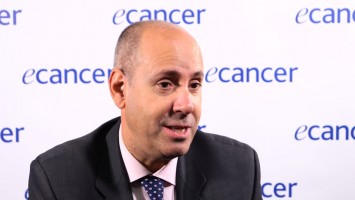We reported a phase I study of GDC-0810 which is an oral selective oestrogen receptor antagonist and degrader.
This drug has a mechanism of action that is similar to fulvestrant in that it binds and degrades the oestrogen receptor.
This study, because it was a first in human drug, tested the agent in women who had been previously treated, who were oestrogen receptor positive, HER2 negative, post-menopausal women who had had prior progression on at least six months of endocrine therapy.
The primary endpoint of the trial was safety and tolerability as well as to determine the maximally tolerated and/or recommended phase II dose.
We treated 41 patients at increasing dose levels and found that at the higher doses tested, at 800mg/day, that women did experience some nausea, some occasional vomiting and diarrhoea.
So we lowered the dose and gave it with some food, with a meal, and found that 600mg/day was most tolerable.
What’s very interesting about this agent is that it’s oral and the PK suggested good bio-availability.
In theory what should a selective oestrogen receptor degrader do for these patients?
As we’re learning more about mechanisms of resistance to endocrine therapy we’re understanding that about 20-50% of women have tumours that harbour an ESR1 mutation.
Those mutant receptors are generally on or in an agonist conformation, even though oestrogen levels may be very low – let’s say they’ve been treated with aromatase inhibitors.
So the focus is now, now that we understand that there are these mutations, we’ve very interested in developing agents that target the oestrogen receptor.
So instead of reducing ligands like the aromatase inhibitors, we want to degrade these receptors, both wild-type and mutant receptors.
So far, of course this is a very early study, but what’s the verdict on your GDC-0810?
Even though this was a phase I trial and really dose was the primary endpoint, we did also assess efficacy and there was some promising activity.
Two patients have had a partial response to therapy.
It’s notable that both of those patients had tumours that harboured ESR1 mutations.
Initially it would be developed to treat ER positive, HER2 negative metastatic breast cancer and if it is proven to be safe and effective it would be an alternative to drugs like fulvestrant.
Fulvestrant is a good agent in vitro but it was always troubled by the fact that it wasn’t very soluble and required an intramuscular injection.
Even with that, there’s poor bioavailability, despite high doses.
So hopefully this drug might be able to, it’s a pill, it’s an oral agent, degrade the oestrogen receptor and have good oral bioavailability.
So this interesting and promising news, what should doctors remember finally about your results now that are potentially of relevance to their clinical practice?
We’re learning a great deal about mechanisms of resistance to endocrine therapy.
As we’re learning about them we’re really designing drugs that may be effective in patients who have endocrine resistant disease.
So there are really a lot of new agents that are being developed as we understand these mechanisms of resistance.








